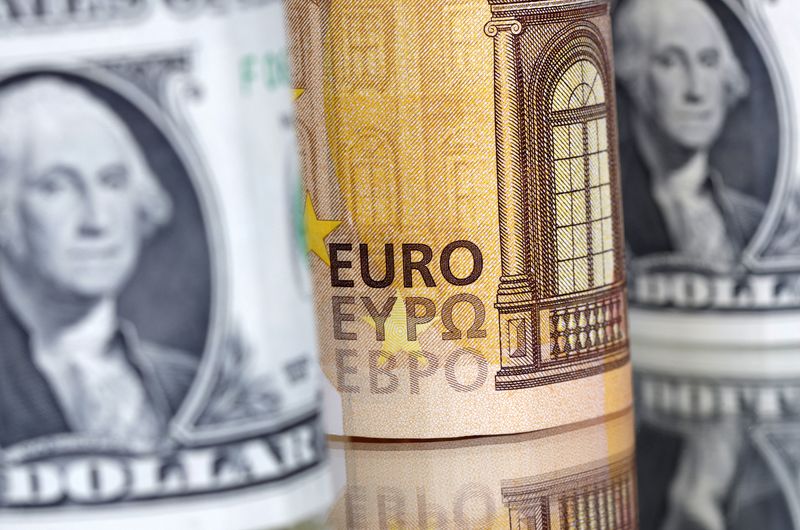Forex
Dollar gains on solid data, euro drops on cautious ECB comments


© Reuters. U.S. Dollar and Euro banknotes are seen in this illustration taken July 17, 2022. REUTERS/Dado Ruvic/Illustration
By Karen Brettell
NEW YORK (Reuters) – The dollar gained on Thursday as U.S. data showed a mixed picture of the American economy, while the euro was weighed down by cautious comments by a leading European Central Bank hawk.
U.S. consumer spending accelerated in July with an 0.8% increase, but slowing inflation strengthened expectations that the Federal Reserve would keep interest rates unchanged next month.
The personal consumption expenditures (PCE) price index rose 0.2% last month, matching June’s gain.
It comes after a string of data this week, including a drop in job openings to the lowest level in nearly 2-1/2 years in July, raised concerns that the economy is slowing.
“The dollar is fairing better as today’s data suggests America’s economic glass remains half full,” said Joe Manimbo, senior market analyst at Convera in Washington.
However, “the dollar does remain in a hole for the week, and that’s because weaker numbers earlier this week cast doubt on the Fed hiking again.”
The was last up 0.54% at 103.66. It has fallen from 104.44 last Friday, the highest since June 1.
Fed funds futures traders see an 89% probability that the U.S. central bank will leave rates unchanged at its September meeting, and are pricing in a 44% likelihood of a hike in November, according to the CME Group’s FedWatch Tool.
Friday’s jobs report for August will be scoured for any confirmation that the labor market is weakening. The data is expected to show that employers added 170,000 jobs during the month, according to the median estimate of economists’ polled by Reuters.
The euro ebbed on Thursday after ECB rate-setter Isabel Schnabel – considered one of the most hawkish members at the ECB – said euro zone growth was weaker than predicted, but that does not necessarily void the need for more rate hikes.
“We’ve heard the most influential hawk on the Governing Council take on a much more cautious tone,” said Michael Brown, analyst at Trader X. “I think the fact she is flagging downside risks to growth is putting some downside pressure on the euro.”
Data on Thursday showed that Euro zone inflation held steady this month, but underlying price growth fell as expected, a mixed picture that complicates life for the ECB as it weighs the merits of a pause in rate hikes in the face of a visible slowdown in growth.
Meanwhile, German unemployment rose more than expected in August, showing the first cracks in what until now had been a very resilient labor market.
Money markets are now pricing in a 70% probability that the ECB will leave rates unchanged at its September meeting.
The euro was last down 0.71% at $1.0845. It is holding above the $1.07655 level reached on Friday, which was the lowest since June 13.
The greenback dipped 0.04% to 146.16 Japanese yen, holding below a 10-month high of 147.375 reached on Tuesday.
China’s yuan strengthened to its firmest in 2-1/2 weeks against the dollar on Thursday after the central bank took measures to support the embattled property sector.
The People’s Bank of China said it would allow existing mortgage rates to be lowered from Sept. 25.
The dollar was last 7.2595 against the , after reaching 7.2485, the lowest level since Aug. 14.
========================================================
Currency bid prices at 9:55AM (1355 GMT)
Descript RIC Last U.S. Pct YTD High Low
ion Close Change PctCha Bid Bid
Previ nge
ous
Sessi
on
Dollar 103.66 103.1 +0.54% 0.164% +103. +103.
index 00 200 7100 0000
Euro/Dol $1.084 $1.09 -0.71% +1.22% +$1.0 +$1.0
lar 5 24 940 841
Dollar/Y 146.16 146.2 -0.04% +11.49 +146. +145.
en 00 250 % 2200 6450
Euro/Yen 158.50 159.7 -0.78% +12.97 +159. +158.
4 % 7300 4200
Dollar/S 0.8835 0.878 +0.56% -4.46% +0.88 +0.87
wiss 5 37 72
Sterling $1.267 $1.27 -0.37% +4.78% +$1.2 +$1.2
/Dollar 0 19 734 661
Dollar/C 1.3526 1.353 -0.07% -0.18% +1.35 +1.35
anadian 4 57 15
Aussie/D $0.647 $0.64 -0.01% -5.01% +$0.6 +$0.6
ollar 5 76 508 463
Euro/Swi 0.9580 0.959 -0.18% -3.18% +0.96 +0.95
ss 7 02 73
Euro/Ste 0.8557 0.858 -0.33% -3.25% +0.85 +0.85
rling 5 98 56
NZ $0.594 $0.59 -0.13% -6.32% +$0.5 +$0.5
Dollar/D 6 56 977 941
ollar
Dollar/N 10.650 10.60 +0.46% +8.52% +10.6 +10.5
orway 0 10 760 780
Euro/Nor 11.555 11.56 -0.08% +10.12 +11.6 +11.5
way 2 50 % 095 423
Dollar/S 10.914 10.83 -0.01% +4.87% +10.9 +10.8
weden 6 68 379 196
Euro/Swe 11.838 11.83 -0.01% +6.18% +11.8 +11.8
den 2 97 922 247

 Forex3 years ago
Forex3 years agoForex Today: the dollar is gaining strength amid gloomy sentiment at the start of the Fed’s week

 Forex3 years ago
Forex3 years agoUnbiased review of Pocket Option broker

 Forex3 years ago
Forex3 years agoDollar to pound sterling exchange rate today: Pound plummeted to its lowest since 1985

 Forex3 years ago
Forex3 years agoHow is the Australian dollar doing today?

 Cryptocurrency3 years ago
Cryptocurrency3 years agoWhat happened in the crypto market – current events today

 World3 years ago
World3 years agoWhy are modern video games an art form?

 Commodities3 years ago
Commodities3 years agoCopper continues to fall in price on expectations of lower demand in China

 Economy3 years ago
Economy3 years agoCrude oil tankers double in price due to EU anti-Russian sanctions





















